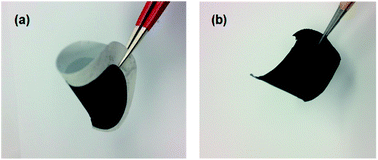Flexible cellulose based polypyrrole–multiwalled carbon nanotube films for bio-compatible zinc batteries activated by simulated body fluids†
Abstract
This work aims to develop biocompatible non-toxic materials for implantable bio-electronic cells. Polypyrrole (PPy)–carbon nanotube (CNT) composites with varied ratios of PPy to CNTs were chemically synthesized and used as cathodes with the support of cellulose paper. Zinc foil was used as the anode material due to its non-toxicity and moderate dissolution rate in aqueous solutions. Simulated body fluids (SBFs) with various protein concentrations were applied as electrolytes in this battery system. The PPy–CNT|Zn cell is capable of being discharged up to 24.5 hours at a current density of 60 μA cm−2 in a protein free SBF. The batteries have also been tested in vitro using SBFs containing bovine serum albumin (BSA) with different concentrations. Such a battery can be charged up to 35.1 hours (1.26 W h) in the electrolyte containing 8 g L−1 BSA, which is 10% of the genuine protein concentration of blood plasma. The effects of adding BSA to the electrolyte on both the anodic reactions and the redox capabilities of the PPy–CNT cathodes are also investigated.


 Please wait while we load your content...
Please wait while we load your content...